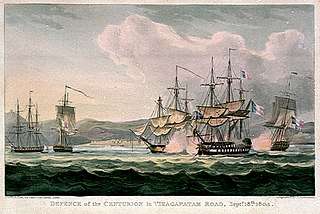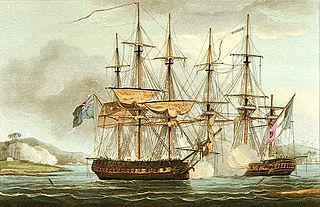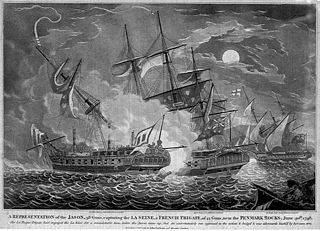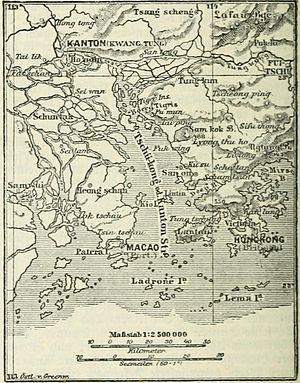
The Battle of Pulo Aura was a minor naval engagement of the Napoleonic Wars, fought on 14 February 1804, in which a large convoy of Honourable East India Company (HEIC) East Indiamen, well-armed merchant ships, intimidated, drove off and chased away a powerful French naval squadron. Although the French force was much stronger than the British convoy, Commodore Nathaniel Dance's aggressive tactics persuaded Contre-Admiral Charles-Alexandre Durand Linois to retire after only a brief exchange of shot. Dance then chased the French warships until his convoy was out of danger, whereupon he resumed his passage toward British India. Linois later claimed that the unescorted British merchant fleet was defended by eight ships of the line, a claim criticised by contemporary officers and later historians.

Admiral of the White Sir William Hargood was a British naval officer who served with distinction through the American War of Independence, the French Revolutionary War and the Napoleonic Wars, during which he gained an unfortunate reputation for bad luck, which seemed to reverse following his courageous actions at the battle of Trafalgar in command of HMS Belleisle.

Jean-Marthe-Adrien L'Hermite was a French sea captain and rear admiral, notable for his involvement in the Glorious First of June and his expedition into the Atlantic in 1805.

The Preneuse was a 44-gun frigate of the French Navy, lead ship of her class, designed by Raymond-Antoine Haran and built at Rochefort. She served as a commerce raider at Île de France.

Linois's expedition to the Indian Ocean was a commerce raiding operation launched by the French Navy during the Napoleonic Wars. Contre-Admiral Charles-Alexandre Durand Linois was ordered to the Indian Ocean in his flagship Marengo in March 1803 accompanied by a squadron of three frigates, shortly before the end of the Peace of Amiens. When war between Britain and France broke out in September 1803, Marengo was at Pondicherry with the frigates, but escaped a British squadron sent to intercept it and reached Isle de France. The large distances between naval bases in the Indian Ocean and the limited resources available to the British commanders in the region made it difficult to concentrate sufficient forces to combat a squadron of this size, and Linois was subsequently able to sustain his campaign for three years. From Isle de France, Linois and his frigates began a series of attacks on British commerce across the Eastern Indian Ocean, specifically targeting the large convoys of East Indiamen that were vital to the maintenance of trade within the British Empire and to the British economy. Although he had a number of successes against individual merchant ships and the small British trading post of Bencoolen, the first military test of Linois squadron came at the Battle of Pulo Aura on 15 February 1804. Linois attacked the undefended British China Fleet, consisting of 16 valuable East Indiamen and 14 other vessels, but failed to press his military superiority and withdrew without capturing a single ship.

The Battle of Vizagapatam was a minor naval engagement fought in the approaches to Vizagapatam harbour in the Coastal Andhra region of British India on the Bay of Bengal on 15 September 1804 during the Napoleonic Wars. A French squadron under Contre-Admiral Charles-Alexandre Léon Durand Linois in the ship of the line Marengo attacked the British Royal Navy fourth rate ship HMS Centurion and two East Indiaman merchant ships anchored in the harbour roads. Linois was engaged in an extended raiding campaign, which had already involved operations in the South China Sea, in the Mozambique Channel, off Ceylon and along the Indian coast of the Bay of Bengal. The French squadron had fought one notable engagement, at the Battle of Pulo Aura on 15 February 1804, in which Linois had attacked the Honourable East India Company's (HEIC) China Fleet, a large convoy of well-armed merchant ships carrying cargo worth £8 million. Linois failed to press the attack and withdrew with the convoy at his mercy, invoking the anger of Napoleon when the news reached France.
The action of 4 August 1800 was a highly unusual naval engagement that took place off the Brazilian coast during the French Revolutionary Wars. A French frigate force that had been raiding British commerce off West Africa approached and attempted to attack a convoy of valuable East Indiamen, two ships sailing for Botany Bay, and a whaler sailing for the South Seas' whale fishery. The small British ship of the line HMS Belliqueux escorted the convoy, which otherwise had to rely on the ships' individual armament to protect them from attack. Due to their large size, the East Indiamen could be mistaken for ships of the line at a distance, and the French commander Commodore Jean-François Landolphe was un-nerved when the convoy formed a line of battle. Supposing his target to be a fleet of powerful warships he turned to escape and the British commander, Captain Rowley Bulteel, immediately ordered a pursuit. To preserve the impression of warships he also ordered four of his most powerful East Indiamen to join the chase.

The Battle of Île Ronde was a minor naval engagement between small French Navy and British Royal Navy squadrons off Île de France, now named Mauritius, in the early stages of the French Revolutionary Wars. The battle was fought over control of the waters around Île de France, which was under blockade from the British squadron as French warships and privateers operating from the island posed a significant threat to vital British trade routes connected to British India and China.

The Battle of Mahé was a minor naval engagement of the last year of the French Revolutionary Wars, fought on 19 August 1801 in the harbour of Mahé in the Seychelles, a French colony in the Indian Ocean. Since the demise of the French Indian Ocean squadron in 1799, the Royal Navy had maintained dominance in the East Indies, controlling the shipping routes along which trade flowed and allowing the rapid movement of military forces around the theatre. French First Consul Napoleon Bonaparte had long-harboured ambitions of threatening British India, and in 1798 had launched an invasion of Egypt as an initial step to achieving this goal. The campaign had failed, and the French army in Egypt was under severe pressure by early 1801, partly due to the presence of a British squadron acting with impunity in the Red Sea.

The East Indies theatre of the French Revolutionary Wars was a series of campaigns related to the major European conflict known as the French Revolutionary Wars, fought between 1793 and 1801 between the new French Republic and its allies and a shifting alliance of rival powers. Although the Indian Ocean was separated by vast distance from the principal theatre of the conflict in Western Europe, it played a significant role due to the economic importance of the region to Great Britain, France's most constant opponent, of its colonies in India and the Far Eastern trade.

The action of 28 February 1799 was a minor naval engagement of the French Revolutionary Wars, fought off the mouth of the Hooghly River in the Bay of Bengal between the French frigate Forte and the Royal Navy frigate HMS Sybille. Forte was an exceptionally large and powerful ship engaged on a commerce raiding operation against British merchant shipping off the port of Calcutta in British India. To eliminate this threat, Sybille was sent from Madras in pursuit. Acting on information from released prisoners, Edward Cooke, captain of Sybille, was sailing off Balasore when distant gunfire alerted him to the presence of Forte on the evening of 28 February. The French frigate was discovered at anchor in the sandbanks at the mouth of the Hooghly with two recently captured British merchant ships.

The action of 9 September 1796 was an inconclusive minor naval engagement between small French Navy and British Royal Navy squadrons off northwestern Sumatra, near Banda Aceh, during the French Revolutionary Wars. The French squadron comprised six frigates engaged in commerce raiding against British trade routes passing through captured parts of the Dutch East Indies, and posed a considerable threat to the weakened British naval forces in the region. The British force consisted of two 74-gun ships of the line hastily paired to oppose the eastward advance of the French squadron.
The Bali Strait Incident was an encounter between a squadron of six French Navy frigates and six British East India Company (EIC) East Indiamen in the Bali Strait on 28 January 1797. The incident took place amidst the East Indies campaign of the French Revolutionary Wars — repeated French attempts to disrupt the highly valuable British trade routes with British India and Qing Dynasty China.

The action of 30 June 1798 was a minor naval engagement fought along the Biscay coast of France during the French Revolutionary Wars. The French Navy had been largely driven from the Atlantic Ocean early in the war following heavy losses in a series of failed operations. This had allowed the Royal Navy's Channel Fleet to institute a close blockade on the French naval ports of the Biscay coast, particularly Brest in Brittany. The blockade strategy included a constantly patrolling inshore squadron composed of frigates, tasked with preventing the passage of French ships into or out of the port. In the spring of 1798, several French frigates stationed in the Indian Ocean were sent back to France as the base at Île de France could no longer supply them effectively. One of these ships was the 40-gun frigate Seine, which departed Port Louis laden with 280 soldiers from the garrison.

The Raid on Manila of January 1798 was a Royal Navy false flag military operation during the French Revolutionary Wars intended to scout the strength of the defences of Manila, capital of the Spanish Philippines, capture a Manila galleon and assess the condition of the Spanish Navy squadron maintained in the port. Spain had transformed from an ally of Great Britain in the War of the First Coalition into an enemy in 1796. Thus the presence of a powerful Spanish squadron at Manila posed a threat to the China Fleet, an annual convoy of East Indiaman merchant ships from Macau in Qing Dynasty China to Britain, which was of vital economic importance to Britain. So severe was this threat that a major invasion of the Spanish Philippines had been planned from British India during 1797, but had been called off following the Treaty of Campo Formio in Europe and the possibility of a major war in India between the British East India Company and the Kingdom of Mysore.
The action of 9 February 1799 was a minor naval engagement of the French Revolutionary Wars between a British Royal Navy frigate and a French privateer frigate fought 100 nautical miles (190 km) west of the southeastern coast of what is now Natal in South Africa. The 32-gun French frigate Prudente had since the start of the war been part of a squadron operating from Île de France. This squadron had dispersed during 1798, with the ships sent on independent commerce raiding operations across the British trade routes in the Indian Ocean. Prudente had subsequently been seized in the autumn of that year by Anne Joseph Hippolyte de Maurès, Comte de Malartic, the Governor of Île de France, and sold to a private raiding company.

The Battle of Port Louis was a minor naval engagement of the French Revolutionary Wars, fought on 11 December 1799 at the mouth of the Tombeau River near Port Louis on the French Indian Ocean island of Île de France, later known as Mauritius. Preneuse had originally been part of a powerful squadron of six frigates sent to the Indian Ocean in 1796 under the command of Contre-amiral Pierre César Charles de Sercey, but the squadron dispersed in 1798 and by the summer of 1799 Preneuse was the only significant French warship remaining in the region. The battle was the culmination of a three-month raiding cruise by the 40-gun French Navy frigate Preneuse, commanded by Captain Jean-Matthieu-Adrien Lhermitte. Ordered to raid British commerce in the Mozambique Channel, Lhermitte's cruise had been eventful, with an inconclusive encounter with a squadron of small British warships in Algoa Bay on 20 September and an engagement with the 50-gun HMS Jupiter during heavy weather on 9–11 October.
Brunswick was launched in 1792 as an East Indiaman for the British East India Company (EIC). She made five complete voyages for the EIC before the French captured her in 1805. Shortly thereafter she wrecked at the Cape of Good Hope.
Europa was a late 18th-century third-rate ship of the line of the Spanish Navy. She was launched in 1789 and served in the Armada Real for 11 years before being abandoned as a wreck in Manila Harbor in 1801.

Fama was a fifth-rate frigate in service with the Spanish and British Royal Navies.













